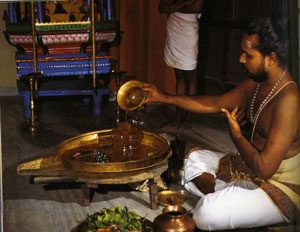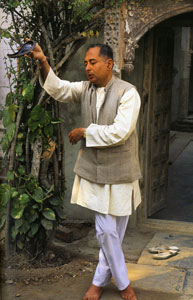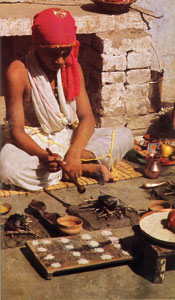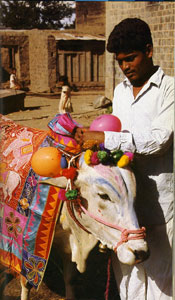
Barbara Bacon
bbacon@canterburyfortmyers.org
Canterbury School, Fort Myers, Florida
| HOME |
| LESSON 1 |
| LESSON 2 |
| LESSON 3 |
| LESSON 4 |
| RESOURCES |
LESSON 1 - ESTABLISHING AN UNDERSTANDING OF RITUAL AND AN INTRODUCTION TO PUJA
RATIONALE
Middle school students often learn best when they can associate new information with something that is familiar in their own lives. The goal of this lesson is to enable students to connect their personal experience and understanding with an introduction to ritual in Hinduism.
MATERIALS
An index card for each student.
PROCEDURE
Distribute an index card to each student.
Ask for a few students to share their ideas.
Ask if anyone repeats these actions/thoughts in subsequent games, performances, events.
Explain that this repetition becomes “ritual.”
Next ask students to write 2-3 descriptive words that describe the volume of voice in their ritual. Examples: soft, silent, loud, joyous.
Elicit whether or not movement is part of their personal ritual.
Ask students where in school life ritual is performed by groups (e.g., cheering at a game).
Move into a discussion of ritual in Hinduism.
ALTERNATIVE PROCEDURES
If time allows, start this lesson by introducing all or part of "Body Ritual among the Nacirema" by Horace Miner. This will challenge students to recognize the American culture from an outsider's point of view and set the stage for examining Hinduism from a possibly unbiased perspective.
Rather than giving writing time on index cards, move directly into a brief discussion by eliciting examples of rituals that are familiar to students in their own lives. Examples might be from their religion, family celebrations/activities, birthday celebrations, sports connections (e.g., athletes who make the sign of the cross before a big play), etc. Extend the discussion as above.
ASSOCIATED VISUALS
 |
"Almost all Hindu rituals of worship include the ceremonial placing of each devotee's hand in fire, symbolizing the cleansing of the soul and lifting of the spirit in devotion. The flames are created by lighted camphor, a substance that burns cool and leaves no residue." (Huyler, 63) |
 |
This rock crystal Linga is being washed with sacred substances and honored with a flame in readiness for prayers. (Huyler, 85) |
 |
"Hinduism is a religion that embraces both conformity and individuality. The means of prayer are as varied as the numbers of devotees. A college professor of engineering strikes a dancer's pose each morning when he prays to the rising sun....With his right hand he pours water from a vessel to honor the River Goddess." (Huyler, 28) |
 |
"This boy is undergoing the rite of thread investiture, one of the most important samskaras in a Hindu's religious life." (Younger, 68) |
 |
"A teenage girl places flowers as the finishing touch on a sacred diagram that she has just drawn on the ground in front of her family's front door. This morning the painting is especially colorful to honor a sacred festival. Some days it is an intricate design crafted only in white, but the girl prides herself on painting a different decoration every day of the year as part of her invocations to the Divine." (Huyler, 55) |
 |
"A bullock is colorfully decorated in preparation for a festival." (Younger, 44) |
 |
Another example of the individuality of Hindu devotion. (Huyler, 252) |